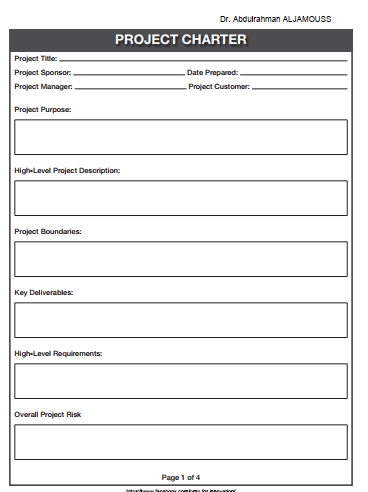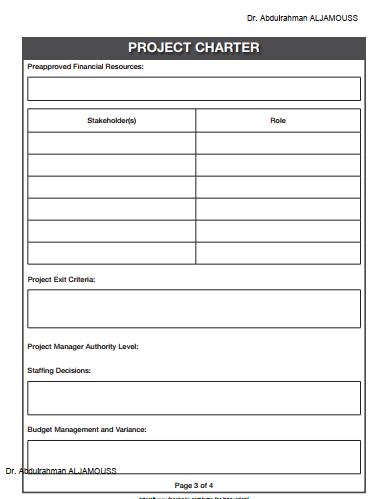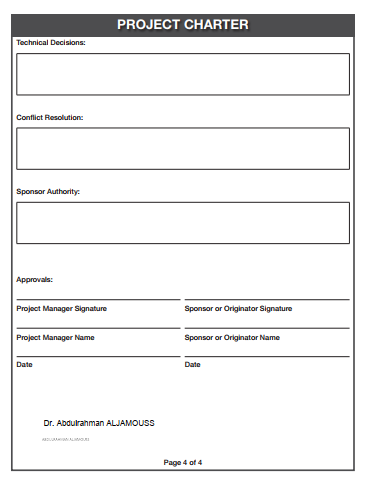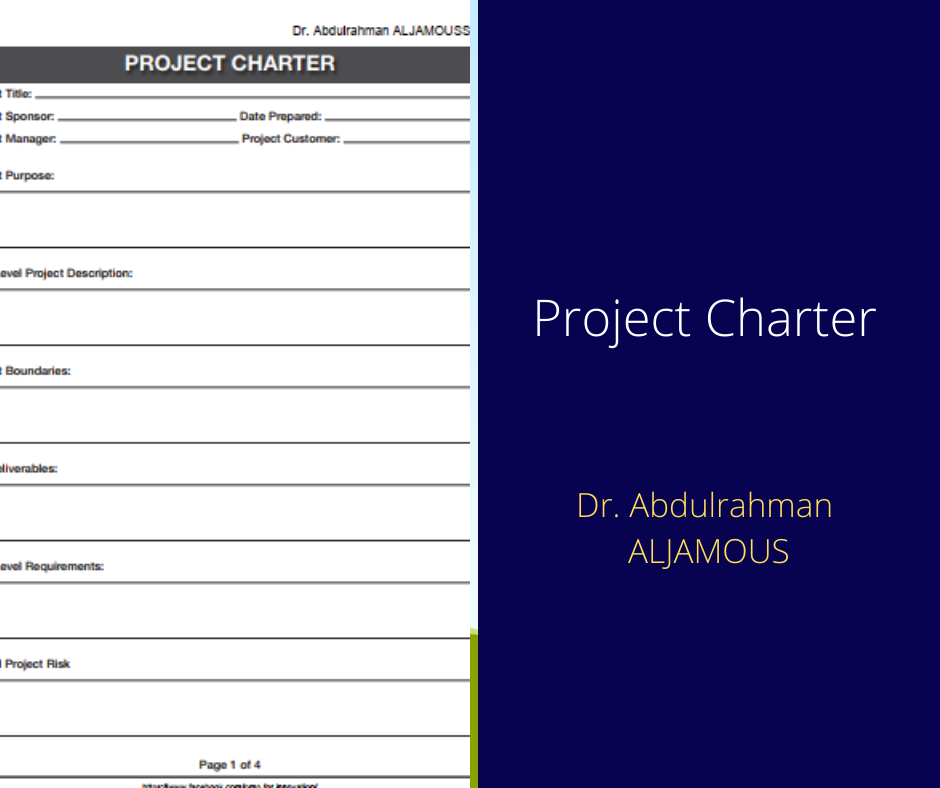Project Charter
Develop Project Charter
Dr. Abdulrahman ALJAMOUSS
Develop project charter the process of developing a document that formally authorizes the existence of a project and provides the project manager with the authority to apply organizational resources to project activities..
The key benefit it provides a direct link between the project and the strategic objectives of the organization, creates a formal record of the project, and shows the organizational commitment to the project.
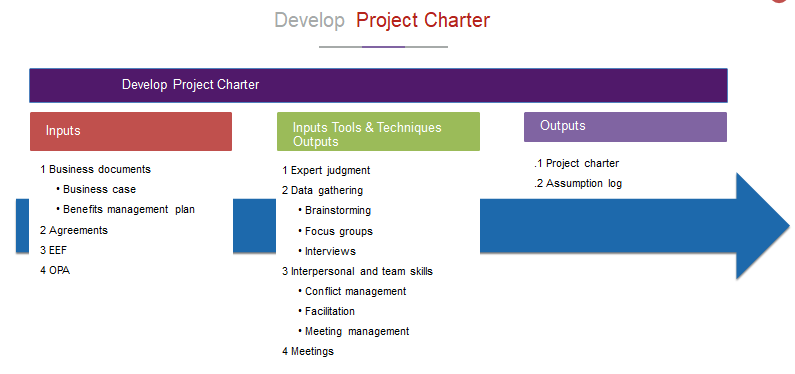
Develop Project Charter: Input
Business documents: Business case: necessary information from a business standpoint to determine whether or not the project is worth the required investment Created as a result from(Market demand, Organizational need, Customer request, Legal requirement, Social need)
Agreements: They are used to define initial intentions for a project. Agreements May take the form of contracts, memorandums of understanding (MOUs), service level agreements (SLA), letters of agreement, letters of intent, verbal agreements, email, or other written agreements, A contract is used when a project is being performed for an external customer.
Enterprise Environmental Factor
Organization Process Asset
Develop Project Charter: Tools & Techniques
Expert judgment: Defined as judgment provided based upon expertise in an application area, Knowledge Area, discipline, industry, etc., as appropriate for the activity being performed. Such expertise may be provided by any group or person with specialized education, knowledge, skill, experience, or training. For this process, expertise should be considered from individuals or groups with specialized knowledge of or training in the following topics:
- Organizational strategy.
- Benefits management.
- Technical knowledge of the industry and focus area of the project.
- Duration and budget estimation.
- Risk identification.
Data gathering
Brainstorming
- Is used to identify a list of ideas in a short period of time.
- It is conducted in a group environment and is led by a facilitator.
- Brainstorming comprises two parts: idea generation and analysis.
- Brainstorming can be used to gather data and solutions or ideas from stakeholders, subject matter experts, and team members when developing the project charter.
Focus group: Bring together stakeholders and subject matter experts to learn about the perceived project risk, success criteria, and other topics in a more conversational way than a one-on-one interview.
Interviews: are used to obtain information on high-level requirements, assumptions or constraints, approval criteria, and other information from stakeholders by talking directly to them.
Interpersonal and team skills
Conflict management: Can be used to help bring stakeholders into alignment on the objectives, success criteria, high-level requirements, project description, summary milestones, and other elements of the charter.
Facilitation: The ability to effectively guide a group event to a successful decision, solution, or conclusion. A facilitator ensures that there is effective participation, that participants achieve a mutual understanding, that all contributions are considered, that conclusions or results have full buy-in according to the decision process established for the project, and that the actions and agreements achieved are appropriately dealt with afterward.
Meeting management: includes preparing the agenda, ensuring that a representative for each key stakeholder group is invited, and preparing and sending the follow-up minutes and actions.
Meetings: meetings are held with key stakeholders to identify the project objectives, success criteria, key deliverables, high-level requirements, summary milestones, and other summary information.
Develop Project Charter: Output
Project Charter: The project charter is the document issued by the project initiator or sponsor that formally authorizes the existence of a project and provides the project manager with the authority to apply organizational resources to project activities, Ensures a common understanding by the stakeholders of the key deliverables, milestones, and the roles and responsibilities of everyone involved in the project
Assumption Log
- High-level strategic and operational assumptions and constraints
- Lower-level activity and task assumptions (technical specifications, estimates, the schedule, risks)
- The assumption log is used to record all assumptions and constraints throughout the project life cycle.
Project charter documents the high-level information on the project such as:
- Project purpose;
- Measurable project objectives and related success criteria;
- High-level requirements;
- High-level project description, boundaries, and key deliverables;
- Overall project risk;
- Summary milestone schedule;
- Preapproved financial resources;
- Key stakeholder list;
- Project approval requirements
- Project exit criteria Assigned project manager, responsibility, and authority level; and
- Name and authority of the sponsor or other person(s) authorizing the project charter.
Project charter
The project charter is a document that formally authorizes a project or phase. The project charter defines the reason for the project and assigns a project manager and his or her authority level for the project. The contents of the charter describe the project in high-level terms, such as:
- Project purpose
- High-level project description
- Project boundaries
- Key deliverables
- High-level requirements
- Overall project risk
- Project objectives and related success criteria
- Summary milestone schedule
- Preapproved financial resources
- Key stakeholder list
- Project approval requirements
- Project exit criteria
- Assigned project manager, responsibility, and authority level
- Name and authority of the sponsor or other person(s) authorizing the project charter
The project charter can receive information from:
- Agreements (contracts)
- Statements of work
- Business case
- Benefits management plan
It provides information to:
- Stakeholder register
- Project management plan
- Scope management plan
- Requirements management plan
- Requirements documentation
- Requirements traceability matrix
- Project scope statement
- Schedule management plan
- Cost management plan
- Quality management plan
- Resource management plan
- Communications management plan
- Risk management plan
- Procurement management plan
- Stakeholder engagement plan
The project charter is an output from process 4.1 Develop Project Charter in the PMBOK® Guide –
Sixth Edition. This document is developed once and is not usually changed unless there is a significant
change in the environment, scope, schedule, resources, budget, or stakeholders.
Tailoring tips: Consider the following tips to help you tailor the project charter to meet your needs:
- Combine the project charter with the project scope statement, especially if your project is small
- If you are doing the project under contract you can use the statement of work as the project charter
in some cases
Alignment :The project charter should be aligned and consistent with the following documents:
- Business case
- Project scope statement
- Milestone schedule
- Budget
- Stakeholder register
- Risk register
Description
You can use the element descriptions in Table 1.1 to assist you in developing a project charter.
